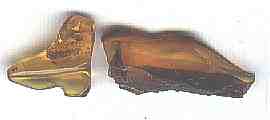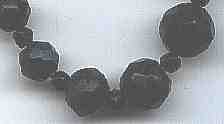Your path =Home>Beadmaking & Materials>Organic Materials> Plants
Precious Beads From Plants
Few precious materials come from plants. When rhubarb came to Europe in 1573, it was extremely expensive. Tulips became so fashionable in Holland that one 'lucky' man paid 2600 guilder for a single bulb in 1637. In comparison, Manhattan Island (the heart of New York City) was bought for 60 guilders of trade goods the year before. Neither rhubarb nor tulips were made into beads.
|
Among the costliest living plant beads are spices, such as cloves. Cloves, nutmeg and mace (the latter two from the same fruit) grew exclusively in the Moluccas (Maluku) Islands of Indonesia, once called "the Spice Islands." Cloves were smuggled out of there and planted in Zanzibar and Pemba, off the coast of East Africa.
Cloves strung into necklaces are worn by Arab brides from southwestern Iran to Yemen. The one above has the cloves strung lengthwise along with old glass trade beads on hand-spun cotton thread. Yet they still retain their scent. Perhaps the value of the spice and the symbolism of the young bride as cook sparked this custom.
True precious beads are made of fossilized plants.
|
Amber is the sap of a tree that was buried and underwent polymerization to turn it into a soft, beautiful "stone." Some amber pieces preserve insects and all sorts of other wonderful things like mushrooms, lizards, frogs, shell fish and even rodent hair (no rodents bodies; our ancestors were big enough to escape).
Our word "electricity" comes from the Greek elektron (electron) meaning amber. Why? If amber is rubbed with wool or silk it builds up a static electric charge strong enough to pick up tiny pieces of paper, lint or whatever. Unfortunately, this characteristic alone is not enough to distinguish amber from certain plastics.
The sale of plastic beads as "African amber," "Copal," "Amber-copal" or other ambiguous names is one of the biggest rip-offs in the bead world.
|
"Copal" is a more recent resin, sometimes buried but not yet totally fossilized. It may also refer to very recent resins. The word is from Nahuatl, the language of the Aztecs, by whom copal was burnt as incense. Semifossilized copal is less common in world markets than amber, and if you should buy some from Zanzibar, China or Korea you would pay the same price as amber. The problem is that "copal" is all too often a euphemism for plastic.
Many plastic beads are billed as amber. Most dealers know they are handling plastic, though some prefer to stay ignorant. Some of big, old plastic beads date from the last century. Dealers tell me that African traders think they are true amber. I suppose this is possible, though it is a stretch.
The beads are said to be scarce and expensive in Africa. This may be. The argument goes that the poor old importing bead dealer has to charge a hefty price for them. That's fine. Just don't call them amber.
Another fossil plant gem is jet. "Jet black" is a literal - the stuff is really black. What is jet, exactly? It's coal. No one knows why it's different from other types of coals (there are a dozen or more types, depending upon how you define them). Some believe jet is made from the woodiest part of ancient plant material.
In any case, jet is a soft, warm material. It takes a high polish well. Its use for beads dates back thousands of years. It was very popular at Petersfels, Germany, more than 20,000 years ago. Beads of jet (or a similar coal) have been historically important in Iran, Korea, Spain, England and Scandinavia for millennia.
A coal bead is one of the earliest beads ever found in America.
|
Many English and Americans believe the craze for jet began when Victoria mourned Albert. Actually, jet (and its glass imitation, "French jet") was used for mourning in France at least as early as 1599. Though the French first made "French jet," most was actually produced in Bohemia, the Czech Republic.
__________________________________________________
Small Bead Businesses | Beading & Beadwork | Ancient Beads | Trade Beads
Beadmaking & Materials | Bead Uses | Researching Beads | Beads and People
Center for Bead Research | Book Store | Free Store | Bead Bazaar
Shopping Mall | The Bead Auction | Galleries | People | Events
The Bead Site Home | Chat Line | Contact Us | Site Search Engine | FAQ




